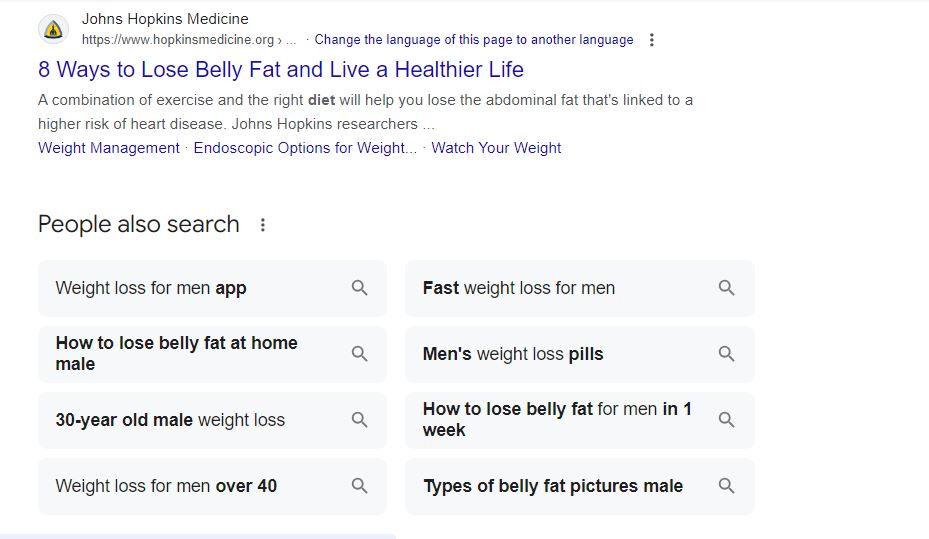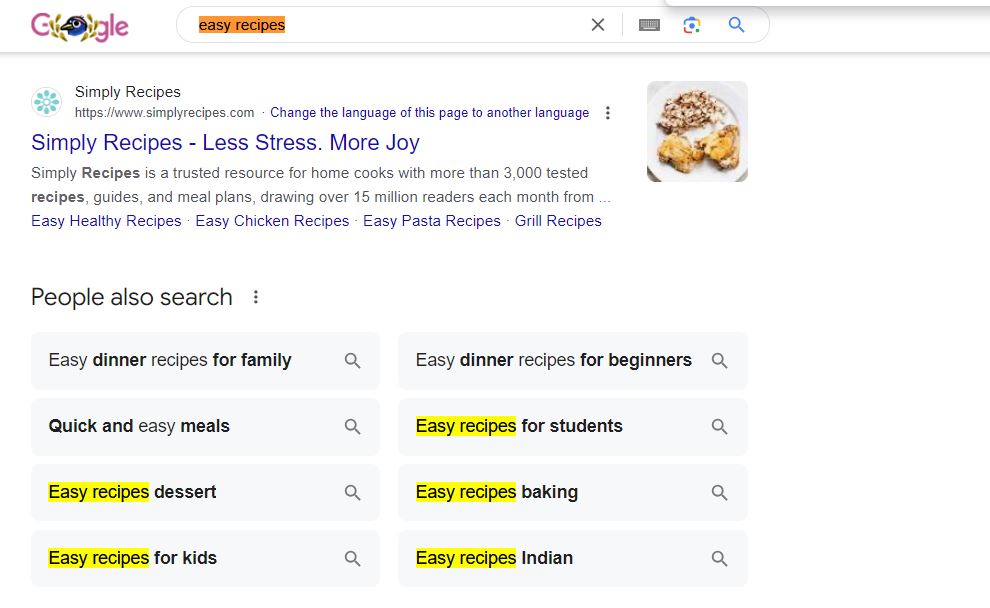Did you know that 68% of online experiences begin with a search engine? This statistic highlights just how integral search engines are to our daily routines.
Millions of people turn to Google daily to find information, products, and services. When we type something into Google, it does more than give us answers to our queries; it also suggests other related searches at the bottom of the page known as Google’s “people also search for” (PASF).
These Google-related searches are more than just helpful hints—they are a goldmine for SEO and content ideas, providing insights into user intent and untapped keyword opportunities.
What are Google’s “People Also Search For”?
 If you have ever searched on Google, chances are that you have seen Google’s ” people also search for” area at the bottom of the results page.
If you have ever searched on Google, chances are that you have seen Google’s ” people also search for” area at the bottom of the results page.
Google’s PASF are the additional search terms at the bottom of a Google SERP. These terms are generated based on what other users have searched for in relation to your initial query.
For instance, if you search for “weightloss for men,” you might find related searches such as “weight loss for men over 40,” “how to lose belly fat for men in 1 week,” or “fast weight loss for me, and more.”
These suggestions are derived from the collective search behavior of millions of users. This makes them highly relevant and valuable for anyone looking to expand their content repertoire or optimize their website for search engines.
Why Google’s “People Also Search For” Are Valuable
Understanding User Intent
One of the primary benefits of Google’s “people also search for” is that they offer a window into user intent. User intent, also called search intent refers to the terms used when performing searches on Google. By examining these related terms, you can gain a better understanding of what users are looking for when they perform a search.
This insight is invaluable because it allows you to tailor your content to meet the specific needs and interests of your audience. When you create content that aligns with user intent, you are more likely to engage your audience, reduce bounce rates, and increase the time users spend on your site.
Finding Content Gaps
Google’s “people also search for” can help you identify content gaps—topics that are not well-covered but in demand.
For example, you might discover a related search term that doesn’t have much quality content available. This presents an opportunity for you to create comprehensive and informative content that fills this gap.
By doing so, you can attract more visitors to your site and establish yourself as an authority in your niche.
Keyword Research
Effective keyword research is crucial for any successful SEO strategy, and “Google’s people also search for” provides a treasure trove of keywords that real users are actively searching for.
These keywords are highly relevant and can help improve your website’s visibility on search engine results pages (SERPs). By incorporating these related search terms into your content, you can increase your page relevancy score and the likelihood of your site being discovered by users searching for similar topics.
How to Use Google’s PASF for SEO
Start with a Broad Keyword
Begin your SEO journey with a broad keyword related to your niche. This keyword should be a general term that encompasses the main topic of your content. For example, if your website is about cooking, you might start with a broad keyword like “easy recipes.”
Look at the Related Searches
 Once you have your broad keyword, enter it into Google and scroll down to the bottom of the search results page. Here, you’ll find a list of related searches. These terms are gold nuggets of information, offering insights into what other users are searching for in relation to your broad keyword.
Once you have your broad keyword, enter it into Google and scroll down to the bottom of the search results page. Here, you’ll find a list of related searches. These terms are gold nuggets of information, offering insights into what other users are searching for in relation to your broad keyword.
Note these related searches down, as they are potential keywords that you can use to optimize your content.
Analyze the Competition
Next, take a closer look at the content that is already ranking for these related search terms. Identify the top-performing articles and analyze what makes them successful. Look for gaps in the content or areas that could be improved.
This analysis will help you create content that not only matches but exceeds the quality of the existing content, giving you a better chance of ranking higher in the search results.
Create High-Quality Content
With your list of related search terms and an understanding of the competition, it’s time to create high-quality content. Ensure that your content is informative, engaging, and provides value to your readers.
Address the needs and questions that users are searching for and use the related search terms naturally throughout your content. This approach will help search engines understand the relevance of your content and improve your chances of ranking higher.
Optimize Your Content
In addition to incorporating related search terms, make sure to optimize your content for SEO best practices. This includes using the related terms in your headings, subheadings, and throughout the text.
Also, ensure that your content is easy to read, with clear and concise language, and properly formatted with bullet points, lists, and images where appropriate. By optimizing your content, you can improve its readability and relevance, which can lead to better search engine rankings and increased traffic.
How to Use Google’s “People Also Search For” for Content Ideas
Brainstorming Topics
When you’re stuck for content ideas, “Google’s people also search for” can be an excellent source of inspiration. They can provide you with fresh perspectives and new angles to cover, helping you break through creative blocks.
By exploring these related searches, you can discover topics that you might not have considered before, giving you a wealth of ideas to work with.
Creating a Content Calendar
 Using Google Related Searches, you can also plan your content calendar more effectively. By identifying the related search terms that are most relevant to your audience, you can schedule your content to address these topics over time.
Using Google Related Searches, you can also plan your content calendar more effectively. By identifying the related search terms that are most relevant to your audience, you can schedule your content to address these topics over time.
This ensures that your content remains timely and addresses the current interests and needs of your audience, leading to better engagement and more consistent traffic to your site.
Writing Series or Guides
If you find several related search terms on the same topic, consider creating a series of articles or a comprehensive guide. This approach allows you to cover a topic in-depth, providing your readers with valuable information and establishing your authority in your niche.
For example, if you discover multiple related searches about “SEO for beginners,” you could create a series of articles that guide beginners through the basics of SEO step-by-step.
Are you Using the PASF Tool?
Google’s “People Also Search For” are a powerful tool for anyone looking to improve their SEO and generate new content ideas. They offer valuable insights into what people are searching for and help you create content that meets their needs.
By understanding and using this Google search tool effectively, you can boost your website’s traffic, fill content gaps, and stay ahead of the competition. So next time you see those related searches at the bottom of the Google page, don’t just ignore them—use them to your advantage!
With regular monitoring, strategic keyword incorporation, and a focus on user experience, you can turn these simple suggestions into a robust SEO and content strategy that drives success for your website or business.




